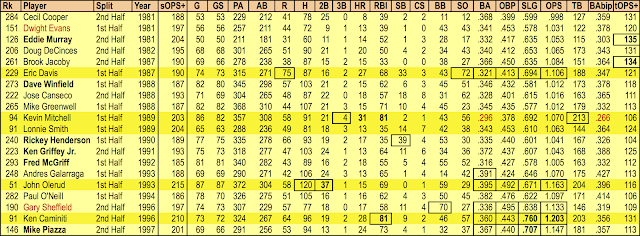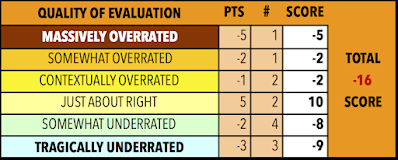THERE HAVE BEEN 35 seasons in which a batter has slugged .700 or higher (nine by Babe Ruth). When we break seasons into halves, it creates roughly four times as many of these high-level slugging feats. There are more .700+ half-season sluggers (128) than there are batters whose BA was .400+ (48) or had a .500+ OBP (52).
Of course, to slug .700--even for a half-season--it helps to hit .300: 97% of the members of the half-season .700 club (roll over, Pat Robertson...) did so. (A year's supply of popsicles to the "savant" who can name the four players to slug .700+ without hitting .300...you'll meet them here in short order).
But, as it turns out, it really helps to hit .350+ while you're doing it. 65% of the half-season .700+ sluggers hit at least .350 when they cracked either the first-half or second-half Top 300. (For sake of completeness, 15 of these folk hit .400+ while slugging at least .700: that's 12%. The last hitter to do so? Why, Barry Bonds, of course.)
Ruth and Bonds will be dominant in this category, despite the relative high number of half-seasons (the most recent of which belongs--of course--to Aaron Judge). And, as with our previous statistical categories, there are very few "mystery guests" on this list. We'll see all 128 shortly, but first let's put up one of our patented (or is that trademarked) TimeGrid™ charts (hmm...guess its trademarked!) to show the historical pattern--you'll see that
at right.
Ruth and George Sisler were the first hitters to slug .700 or higher in a half-season: they both did it in 1920. Ruth was the first, however, as he slugged over .800 in both halves of the 1920 season, while .400+ hitter Sisler just slipped over the .700 line (.702, to be exact) in the second half. The two of them kicked off a wave of such half-seasons from that point, with 50 more occurring over the next two decades, including eight .700+ SLG half-seasons in 1930 alone.
But it would take six decades (1940s through 1990s) for hitters to slip past the total of .700+ SLG half-seasons that occurred in the 1930s, with the totals in the '70s and '80s barely registering a blip on the radar gun. The offensive explosion morphed into high-level slugging in the second half of the '90s with the likes of Mark McGwire and Sammy Sosa (and let's not overlook the mostly forgotten Albert Belle); the slugging onslaught went into overdrive in 2000-01, with 13 such half-seasons, and the first decade of the 21st century slipped past the '30s mark (with benefit of twice as many teams, of course). Even with the homer barrage in the second half of the 2010s, the incidence of .700+ SLG half-seasons slipped back to '90s levels--and one suspects that we'll be lucky to see frequencies similar to what we saw back in the 1950s.
Let's get started with the roll call of these half-season slugging peaks:
There are 25 half-seasons in the 1920s, 14 of them by Babe Ruth. Rogers Hornsby has seven: he also hit .400+ in five of those half-season, peaking at #13 overall in the second half of his 1924 season, where he has a dizzying slash line: .451/.541/.767. The other four hitters who squeezed onto the list: Lou Gehrig, Jim Bottomley, Harry Heilmann, and the aforementioned Sisler.
Buried in the data is an intriguing "back to front" achievement by the Babe. (Remember that "back to front" is our way of combining a second half of Year 1 with a first half of Year 2.) In the second half of his 60-homer season in 1927, Ruth hit 31 HRs. What's been lost to us until now is the fact the the Babe hit 32 homers in the first half of 1928: when you add those two half-seasons together, you find that Ruth hit 63 HRs over 151 games in this "back to front" configuration.
On to the 1930s:
As you'll see, the Babe wasn't quite done: he had three more of these half-seasons from 1930-32. He's supplanted by Jimmie Foxx, who compiled seven .700+ SLG half-seasons during the decade. Close on Foxx' heels is Lou Gehrig, with five. Of the 28 half-seasons here, the vast majority (21) occur in the AL, which remained a slugging league throughout the decade. In 1936, Bill Dickey becomes the first catcher to crack the .700 SLG level, with .703 during the first half of the year. A year later, the Yankees' platoon outfielder George Selkirk matches Dickey. And which second half do you prefer in 1938: Foxx' workmanlike .701, Hank Greenberg's then-record second-half HR total (36), or Johnny Mize's lower HR totals but huge all-around hitting (.389, .750 SLG)?
Now we move into the more "fallow period" of .700+ SLG half-seasons, the period from 1940-1999 where instead of seeing two of these per year, as was the case in the 20s/30s, we see a frequency that's more like one every two years:

The big-hitting names of this period are all here, but with greatly diminished frequency. The man who shows up here the most is also the most maligned players in baseball history: Mark McGwire (four appearances clustered around his HR-hitting exploits from 1996-2000). Ted Williams, Stan Musial and Mickey Mantle all make three appearances, with two each from Willie Mays, Duke Snider, Larry Walker, and (wait for it...) Albert Belle. In the midst of McGwire's now-shunned 70-HR season in 1998, when he slugged over .700 in both halves of the season, Belle's second half produced the highest half-season SLG in forty years, an unfathomable .816, boosted in part by a .387 BA, exactly one hundred points higher than that turned in by Reggie Jackson in 1969, the only man to have more extra-base hits than Belle (but whose half-season contained seventy more plate appearances).
Check that--Musial's second half in 1949 has more XBH that Belle in 1998, as does Belle himself in his 1995 second half (where he slugs .787). Ditto for Edgar Martinez, whose doubles pace in the first half of 1996 was such that he appeared to be a lock to break Earl Webb's record for most two-base-hits in a season (he didn't). The one-off half-seasons here are undeniably intriguing: Roger Maris, not in his 61 HR year of 1961, but in his first half-season as a Yankee the year before; the homer exploits of Hank Aaron and Willie Stargell in 1971; George Brett's curtailed hot streak in 1983; ditto for Mike Schimdt in the strike season two years earlier; Ken Caminiti's astonishing (and controversial) eruption in the second half of 1996; and Mike Piazza's valiant attempt to carry the Dodgers to a division title in 1997 (he didn't).
As noted, the pace of these .700+ SLG half-seasons picked up in the late 90s, and just exploded in every direction in the decade that followed:
Of course, some of this renascence of half-season slugging prowess is due to the presence of Barry Bonds, who appears on this list nine times. That's not quite as dominant as Ruth was in the 20s, but the Babe had the advantage of being the original "Sultan of Swat" and didn't have much "competish" for the first half of that decade. Bonds' four seasons from 2001-04 are both glorious and infamous: it's one of the staining aspects of baseball "discourse" in the 21st century that his achievements here are shunned and reviled instead of being celebrated as among the most astonishing sustained feats in the history of the game.
When Bonds finally subsides in 2004, his mantle is taken up by Albert Pujols, who generates four .700+ SLG half-seasons through to the end of the decade. Another reviled player getting punished in the Hall of Fame voting, Manny Ramirez, shows up here eight years apart (2000 and 2008, the year of "Mannywood" in Los Angeles). Sammy Sosa, yet another rejected/ejected slugger, contributes two impressive second halves in the slugger supernova years of 2000-01. And Todd Helton, about to go in the Hall of Fame, slips on the list twice with Coors Field-enhanced totals.
Again, the one-off players here are both interesting (and possibly suspicious to some): Carlos Delgado, Luis Gonzalez, Jason Giambi, Jim Thome; Javy Lopez (only the third catcher on the list), Jim Edmonds, Derrek Lee (on fire in the first half of 2005), Ryan Howard (ditto in the second half of 2006).
The seasonal frequency of .700+ SLG half-seasons starts to wane in the second half of the 2000s, leading toward a downturn that follows in the 2010s. "Launch angle" mishegas eats away at overall batting average, which (as noted) is still a factor in fueling .700+ SLG, so the players who've achieved in recent times have a strong tendency to be in the midst of blistering short-term career peaks:
The "tOPS+" column, which measures how much higher the player's half-season OPS is relative to his OPS for the entire season, shows a pronounced uptick here. Two hitters--Jose Bautista and Christian Yelich--have "back to front" season-length short-term peaks that are astonishing in their intensity: Bautista actually hits 61 HRs in his conjoined half-seasons, while Yelich is not far behind with 56. Who knew? (That's a preview of some of the "back to front" conjoined seasons we'll be seeing in this space later in 2023--stay tuned.)
The only other hitter on this list twice is Bryce Harper (first half of 2015, second half of 2021). Mike Trout, a steady .600 SLG kind of guy, cracks the list only once, in 2017 (during the first of what's turned into an unsettling trend of injury-related absences). The other names here often involve massive in-season hot streaks: David Ortiz and Edwin Encarnacion in 2015 (check those tOPS+ values). There are some fun one-offs here: Mike Napoli (the fourth catcher on the list); the flame-on, flame-out Chris Davis; the desert summer of J.D. Martinez (calculate that HR/PA ratio, and remember it was 2017); Nelson Cruz, continuing the renaissance of right-handed sluggers in the fever-dream year of "launch angle."
And, finally, Aaron Judge, whose second half scald carried him to the AL home run record with the highest half-season SLG since Bonds in 2004. How hot was he? Keep that "tOPS+" figure in mind and realize that Judge hit 33 HRs in the first half of 2022! That's how hot he was--hot enough to make people turn away from a fraught mid-term election and focus intently on his simultaneous chase of Maris' "Yankee HR record" and the fortunes of his suddenly flailing team that had looked like an all-time juggernaut until going kersplat in August. What reckoning will the Yankees really face for having to pay through the nose to retain Judge, who probably won't approach these heights again? That's part of what we'll all witness in the intervening years, as America attempts to fend off its carload of careening cretins hell-bent on having a heinous "hot streak" of their own. ("Launch angle" is the bane both of baseball and politics, n'est-ce pas?)

Finally, let's take our .700+ SLG half-seasons and combine them with what we've seen previously for .400+ BA and .500+ OBP to examine a Time-Grid™(there's that trademark again...) which puts them all together. Doing it in this way, of course, will double-count (and occasionally triple-count) the same half-season, but it's still a good "heat map" of overall short-term peak performance. The results smooth out these separate-but-related achievements a bit, but reinforce the notion that the clustering we still see in this data occurs in large part from the dominance of
Babe Ruth and
Barry Bonds in their respective eras. We shun and discount Bonds to our own detriment...

































